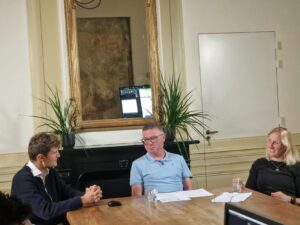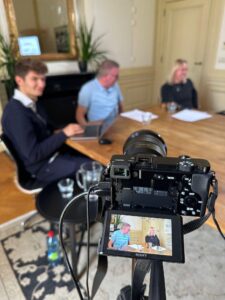
blogs
Cultivating Sustainability Skills: The Evolving Role of L&D
Key Takeaways from the Inchainge Fireside Chat with Industry Experts
Imagine a world where every professional, regardless of their specialty, understands sustainability as intimately as they understand their own field of expertise. The need to close the sustainability skills gap is more urgent than ever, and industry experts are coming together to explore how this can be achieved.
Inchainge facilitated a fireside chat to delve deep into this pressing topic. Our host Noah Schaul, director of Corporate Training at Inchainge, was joined by two distinguished guests: Marco Rog, Co-owner/Circular Strategist at Circular Clarity, and Monica Zeilemaker, Senior consultant and Creator of the sustainability movement at TMC. In this blog, we share the most insightful takeaways from this thought-provoking conversation.
Cultivating a Sustainable Culture through Learning & Development
Marco Rog initiates the conversation with a thought-provoking question – “How to create the right mindset, the right knowledge, and make that step towards the circular economy?”.
Marco firmly believes that people are at the heart of circularity, a view echoed by Monica Zeilemaker. Monica noticed a global acceleration in sustainability trends in 2020, around the same time the masterclass on circularity was born – all thanks to a compelling LinkedIn post by Marco and a strategic decision by her director.
“How to create the right mindset, the right knowledge, and to make that step towards the circular economy”- Marco Rug
This masterclass, as explained by Marco and Monica, targets professionals across the business, manufacturing, and supply chain sectors. Its ambitious goal? Not just to spark discussion on sustainability and inspire steps towards circularity, but also to foster a transformative experience for the participants.
This transformation is designed to go beyond instilling knowledge — it’s about empowering participants with the skills, the understanding, and, crucially, the right mindset to catalyze further learning and development throughout their careers.
Monica underscored the effectiveness of moving together as a tribe to keep everyone motivated. In this learning environment, trainers evolve from being mere lecturers to becoming facilitators, fostering a safe and collaborative space for transformation.
In Monica’s words, the essence of these programs is to “turn something theoretical into something practical.” This sums up the core aim of learning and development initiatives – creating a bridge between knowledge and actionable change, thereby fostering a culture deeply rooted in sustainability.
As the conversation unfolded, our host Noah brought up a valuable point, likening sustainability to a moving target. “Sustainability is not static; it’s dynamic and ever-changing. That’s why continuous learning and adaptability are vital in keeping up with it,” he pointed out.
His insight underscores that the journey towards sustainability is ongoing. It’s not just about reaching a certain point, but being ready to move and evolve as the target shifts.

Each Voice Counts: Collaborative Steps towards Sustainability Expertise
The fireside chat led us to the realization that becoming an expert in sustainability is a lifelong journey, not a quick sprint. Monica and Marco agreed that addressing such a complex subject doesn’t have a one-size-fits-all answer. Monica’s advice? Industries should adapt to the changing environment with a positive mindset.
To this end, she advocates for lighthearted experimenting as a pathway towards learning and adaptation. According to Monica, simulation games offer the ideal environment for such safe and exploratory experiments, acting as stepping stones in our journey towards sustainability.
During our chat, the sustainability skills gap emerged as a significant issue. Monica painted a clear picture: “87% of our engineer population wants to know more about sustainability. Yet, they feel they lack the necessary skills.” That’s a wake-up call. Engineers are keen on contributing to sustainability, but they need the right perspective to utilize their skills effectively.
Interestingly, Monica points out that in many cases, engineers already possess excellent technical skills. The real gap lies in applying these skills within a broader, sustainability-focused systems view. By illuminating this bigger picture, we can empower these professionals to initiate and engage in dialogues within their companies, fostering an environment that breeds action towards sustainability.
To bridge this gap, we need to shake things up. Companies need to encourage open conversations and dialogue. Monica and Marco agreed that governments, company leaders, and individuals all play a role in promoting sustainability. As Marco put it, “We have to do it step by step together. So not siloed, but together and also the joint boards of companies.”

The Impact of Sustainable Leadership on Bridging the Skills Gap
Sustainable leadership was another focus of our fireside chat. Monica spoke about the importance of personal leadership skills, emphasizing networking, having co-creative dialogues, and aligning with stakeholders sharing similar values. She noted that this alignment is particularly crucial when it comes to attracting young talent.
“There are leaders who have the courage to at least put it on the table and say: this is where we are at this moment. […]I think this is what is crucial for me as part of future leadership around sustainability”- Marco Rog
“Collaboration is key,” Monica noted, “Working with like-minded individuals, teams, and organizations speeds up our journey towards sustainability.” On the other hand, Marco noticed that the younger generation, which includes students and fresh graduates, crave diverse and inclusive work environments. They’re open to voicing their constructive criticism and eager to shape their companies’ futures.
“The leaders of tomorrow are already here, and they’re not afraid to speak up,” Marco remarked. “It’s up to us, the leaders of today, to listen, learn, and create a space where they can thrive.” Monica agreed, reinforcing the importance of connectivity and active listening in sustainable leadership. She emphasized the need for unity and collaboration rather than divisions.
“So not polarize, but connect and listen” ”- Monica Zeilemaker
Moreover, the emerging wave of young professionals entering the workforce doesn’t shy away from bold ideas and collaborative action. They’re fans of flat organizational structures and shared decision-making processes. This new mindset calls for current leaders to welcome their input, foster collaboration, and embrace less hierarchical structures. By doing so, we’re not just making workplaces more inclusive; we’re paving the way for innovative solutions to sustainability challenges.
In the end, the message was clear: effective sustainable leadership plays a vital role in closing the sustainability skills gap. Leaders have the power to nurture an environment that promotes continuous learning and active participation in sustainability initiatives. They are the ones shaping a future where sustainable practices become commonplace rather than exceptions.
Join the Conversation on Sustainability: Inchainge Fireside Chats
Ready for deeper insights on sustainability and other trending topics? Join our Fireside Chats!
Stay updated and engage with industry experts. You can now also watch back previous chats.
